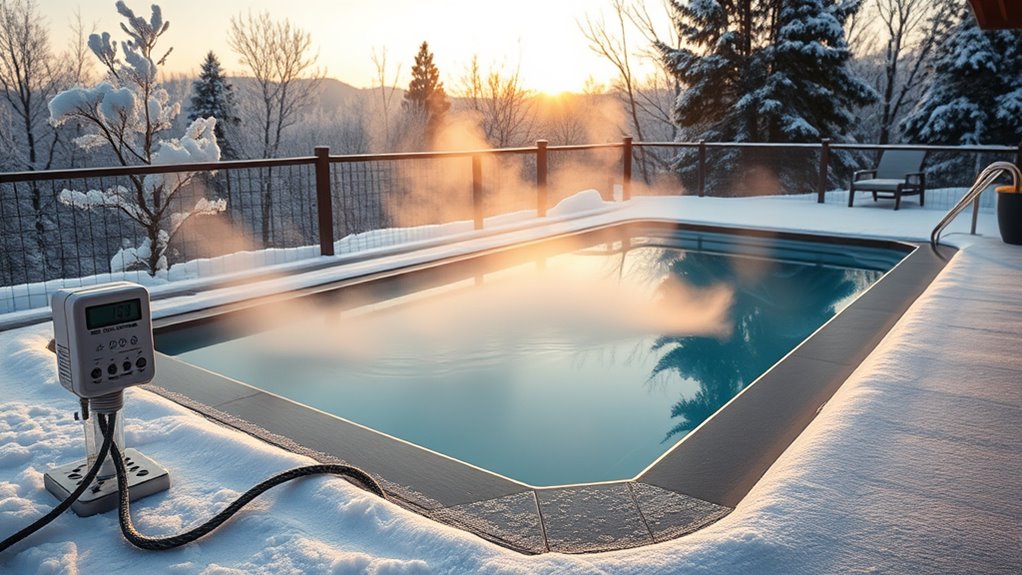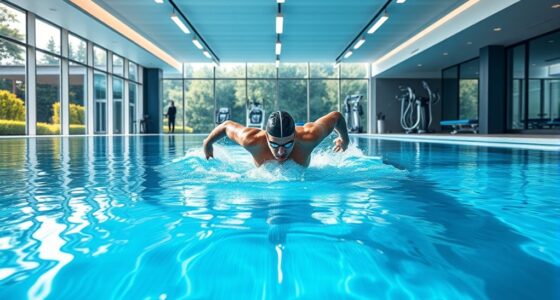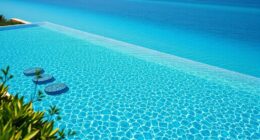Your endless pool’s operating costs depend on factors like size, usage, and heating method. The main expenses come from running pumps, circulation, and heating systems, which vary with outdoor weather and your temperature preferences. Electric resistance heaters are costly, while heat pumps and solar options can save money over time. To better understand how to cut costs and optimize efficiency, continue exploring ways to manage your pool’s energy consumption effectively.
Key Takeaways
- Electricity costs depend on pool size, pump power rating, usage hours, and local electricity rates.
- Heating expenses vary with outdoor temperature, heating method, pool insulation, and seasonal demand.
- Using energy-efficient pumps, timers, and pool covers can significantly reduce operational costs.
- Seasonal fluctuations influence heating needs, with higher costs in colder months and savings in milder weather.
- Proper maintenance and smart management strategies optimize energy use and minimize ongoing electricity and heating expenses.
Factors Influencing Electricity Consumption of Endless Pools

The electricity consumption of endless pools largely depends on several key factors that you can influence. First, the size and volume of your pool matter; larger pools require more energy to circulate water and maintain temperature. The frequency and duration of use also impact energy needs—more frequent and longer sessions increase consumption. The pump’s power rating determines how much energy is used during operation, with higher-rated pumps consuming more. Additionally, your pool’s insulation quality affects heat retention, reducing the workload on your heater and saving energy. Finally, the ambient temperature and weather conditions influence heating requirements; colder climates demand more energy to keep the water warm. By understanding these factors, you can better manage your pool’s energy efficiency and control costs.
Typical Power Requirements for Running an Endless Pool

Running an endless pool typically requires between 1 and 3 kilowatts of power during operation, depending on its size, features, and usage patterns. Smaller models with basic features tend to use closer to 1 kilowatt, while larger or more advanced pools may draw up to 3 kilowatts. The pump, circulation system, and filtration units are the main power consumers, running continuously to keep water clean and moving. If you add features like jets, lighting, or advanced controls, expect a slight increase in energy use. Additionally, performance upgrades such as enhanced circulation systems can influence overall energy consumption. Your actual consumption depends on how often and how long you run the pool each day. Overall, understanding these typical power requirements helps you estimate operating costs and plan for energy expenses effectively.
Heating Options and Their Impact on Energy Costs

Choosing the right heating option considerably impacts your endless pool’s energy costs. Electric resistance heaters are common but can be expensive to operate, especially in colder climates. Heat pumps, on the other hand, use electricity more efficiently by extracting heat from the air, reducing energy consumption markedly. The refrigeration cycle is fundamental to how heat pumps transfer heat efficiently. Gas heaters offer quick heating and lower operational costs if natural gas is available, but they do emit greenhouse gases. Solar heating is eco-friendly and can cut costs long-term, though initial setup can be costly and dependent on sunlight availability. Your choice depends on your climate, budget, and sustainability goals. Consider the upfront costs versus ongoing energy expenses to find the most cost-effective and efficient heating method for your pool.
Estimating Monthly Electricity Expenses

To estimate your monthly electricity expenses for an endless pool, start by calculating the pool’s energy consumption based on your chosen heating method and usage patterns. Determine how many hours you plan to use the pool each day and the average power draw of your heating system. Check the pool’s specifications for its wattage or kilowatt rating, then multiply that by your daily usage hours to find daily energy consumption. Multiply that figure by 30 to get a monthly estimate. Don’t forget to include the energy used by circulation pumps and lighting, if applicable. Finally, multiply your total kilowatt-hours by your local electricity rate to estimate your monthly cost. This approach provides a clear view of your ongoing electricity expenses. Additionally, understanding the total‑cost clarity of your setup can help you plan for long-term expenses more effectively.
Strategies to Reduce Energy Consumption and Costs

To cut your pool’s energy costs, start by optimizing how often and when you use it. Upgrading to energy-efficient equipment can also make a big difference in reducing power consumption. Implementing these strategies helps you save money while keeping your pool enjoyable. Additionally, proper insulation and temperature control can minimize heating expenses and improve overall energy efficiency. Energy-efficient projectors
Optimize Pool Usage
Optimizing your pool usage can substantially cut energy consumption and lower operating costs. By adjusting your swimming schedule, you avoid unnecessary heating and filtration during low usage times. Keep your pool cover on when not in use to retain heat and reduce evaporation. Use timers to control circulation and heating systems, ensuring they’re only active when needed. Additionally, maintain proper water levels to enhance pump efficiency. Here’s a quick comparison:
| Strategy | Benefit |
|---|---|
| Limit swimming hours | Reduces heating and filtration costs |
| Use a pool cover | Retains heat, reduces evaporation |
| Schedule circulation with timers | Prevents unnecessary energy use |
| Maintain water levels | Keeps pumps running efficiently |
| Regular maintenance | Ensures systems operate at their best |
Implementing these tips helps maximize efficiency and cut costs.
Upgrade Equipment Efficiently
Upgrading your pool equipment is one of the most effective ways to reduce energy consumption and lower operating costs. Modern, energy-efficient devices use less power and operate more effectively. To maximize savings, consider these upgrades:
- Install a variable-speed pump that adjusts flow rate based on demand.
- Replace old heaters with energy-efficient models that heat faster and retain heat better.
- Upgrade lighting to LED systems, which consume markedly less energy.
- Use a smart controller to optimize equipment operation and reduce unnecessary energy use.
- Incorporate best beaches and scenic destinations into your planning to enjoy relaxation and rejuvenation after maintenance.
These improvements not only cut your electricity bills but also extend the lifespan of your equipment. Investing in efficient technology ensures your Endless Pool runs smoothly while saving you money in the long run.
Comparing Different Heating Methods and Their Efficiency

When it comes to heating your endless pool, choosing the right method can considerably impact your operating costs and energy efficiency. Electric heaters are quick and easy but can be costly over time. Heat pumps use less energy, making them more economical but have higher upfront costs. Gas heaters heat faster and may be cheaper to operate if gas prices are low. Here’s a comparison:
| Method | Efficiency & Cost |
|---|---|
| Electric | High operating cost, low upfront |
| Heat Pump | Energy-efficient, moderate cost |
| Gas | Fast heating, variable costs |
Additionally, understanding the wave and wind energy sources can influence your overall energy strategy and help optimize your pool heating options.
Your choice depends on your budget, climate, and how often you’ll use the pool. Weigh these factors to find the most efficient solution for your needs.
Seasonal Variations in Operating Costs

As temperatures change throughout the year, your pool’s operating costs can vary markedly. You might spend more on heating during colder months and save during off-seasons. Understanding these fluctuations helps you plan better and find strategies to reduce expenses when the weather isn’t ideal. Incorporating efficient mixing techniques into your pool’s heating system can further optimize energy consumption and control costs.
Temperature Fluctuations Impact
Temperature fluctuations throughout the year can considerably impact your endless pool’s operating costs. As outdoor temperatures change, your heating system works harder during colder months, increasing energy expenses. Conversely, milder weather reduces heating needs, lowering costs. To optimize your budget, consider these factors:
- The need for increased heating during winter months.
- The effect of outdoor temperature swings on insulation efficiency.
- The potential for energy savings with a cover to retain heat.
- The impact of ambient temperature on pool heater performance.
Off-Season Savings Strategies
During the off-season, you can substantially cut your endless pool’s operating costs by adopting strategic savings methods. First, lowering the pool’s temperature when not in use reduces heating expenses without sacrificing comfort. Consider setting the thermostat a few degrees lower and using a timer to run the heater only during the most convenient times. Insulating the pool and pipes helps retain heat, minimizing energy loss. Covering the pool with a high-quality cover when unused prevents heat escape and reduces evaporation, saving both heating and water costs. Additionally, maintain your equipment regularly to ensure it runs efficiently, avoiding unnecessary energy consumption. By implementing these strategies, you’ll keep your operating costs lower during the off-season while maintaining your pool’s longevity and readiness for when you want to swim again.
Tips for Monitoring and Managing Your Pool’s Energy Usage

Monitoring and managing your pool’s energy usage is essential to keep operating costs in check. By staying attentive to your pool’s energy consumption, you can identify areas for efficiency improvements. Here are four tips to help you stay on top of your energy management:
- Install a pool energy monitor to track real-time electricity and heating usage.
- Regularly inspect and clean filters to ensure ideal flow and efficiency.
- Use programmable timers to operate your pool equipment during off-peak hours.
- Adjust temperature settings slightly lower to reduce heating costs without sacrificing comfort.
- Be aware of energy-efficient equipment options that can further decrease your pool’s operational expenses.
Implementing these strategies enables you to maintain control over your pool’s energy consumption, ultimately saving money and extending the lifespan of your equipment.
Frequently Asked Questions
How Long Does It Take to Recoup Heating Costs Through Energy Savings?
It generally takes between 1 to 3 years to recoup your heating costs through energy savings. Factors like your local climate, pool size, insulation, and usage frequency influence this timeline. If you invest in energy-efficient heating options and maintain your pool well, you’ll see savings faster. Keep track of your energy bills to monitor your progress, and you’ll notice the break-even point sooner than you might expect.
Are There Government Incentives for Installing Energy-Efficient Pool Heating Systems?
You might find that government incentives for installing energy-efficient pool heating systems are worth exploring, as they often offer rebates or tax credits to help lighten your load. These programs can vary by location and change over time, so it’s wise to do your homework. By taking advantage of these incentives, you can save money upfront and make your investment more affordable, turning a potential hot potato into a win-win situation.
How Does Ambient Temperature Influence Overall Energy Expenses?
Ambient temperature directly impacts your energy expenses by affecting the amount of heating needed to maintain your desired pool temperature. When it’s colder outside, your heater works harder, increasing energy costs. Conversely, warmer ambient temperatures reduce heating needs, lowering expenses. To save, consider insulating your pool area or using a cover, which helps retain heat. Monitoring outdoor weather patterns also helps you plan better and manage your energy consumption effectively.
What Are the Long-Term Maintenance Costs Associated With Different Heating Options?
Long-term maintenance costs for heating options vary depending on your choice. Electric heat pumps generally have lower ongoing expenses and fewer repairs, while gas heaters may require more frequent servicing and higher energy costs over time. Solar heating can reduce expenses long-term but involves higher upfront costs and maintenance. You should consider your climate, initial investment, and ongoing costs to select the most cost-effective, reliable heating option for your endless pool.
Can Solar Energy Significantly Offset the Electrical Costs of Operating an Endless Pool?
Yes, solar energy can substantially offset your endless pool’s electrical costs. While installing solar panels requires upfront investment, they generate free, renewable power, reducing your reliance on grid electricity. During sunny days, your pool stays heated with minimal extra expense, making solar a smart, eco-friendly choice. Over time, it can dramatically lower your energy bills, turning your luxury into a sustainable and cost-effective oasis.
Conclusion
Your endless pool is more than just water and electricity; it’s a reflection of your commitment to wellness and balance. By understanding and managing your energy costs, you’re nurturing a harmony between comfort and sustainability. Every effort you make to reduce consumption is like tending a garden—small acts that cultivate long-term serenity. Keep monitoring, adjusting, and caring for your pool, and it will continue to be a symbol of your mindful pursuit of health and harmony.









